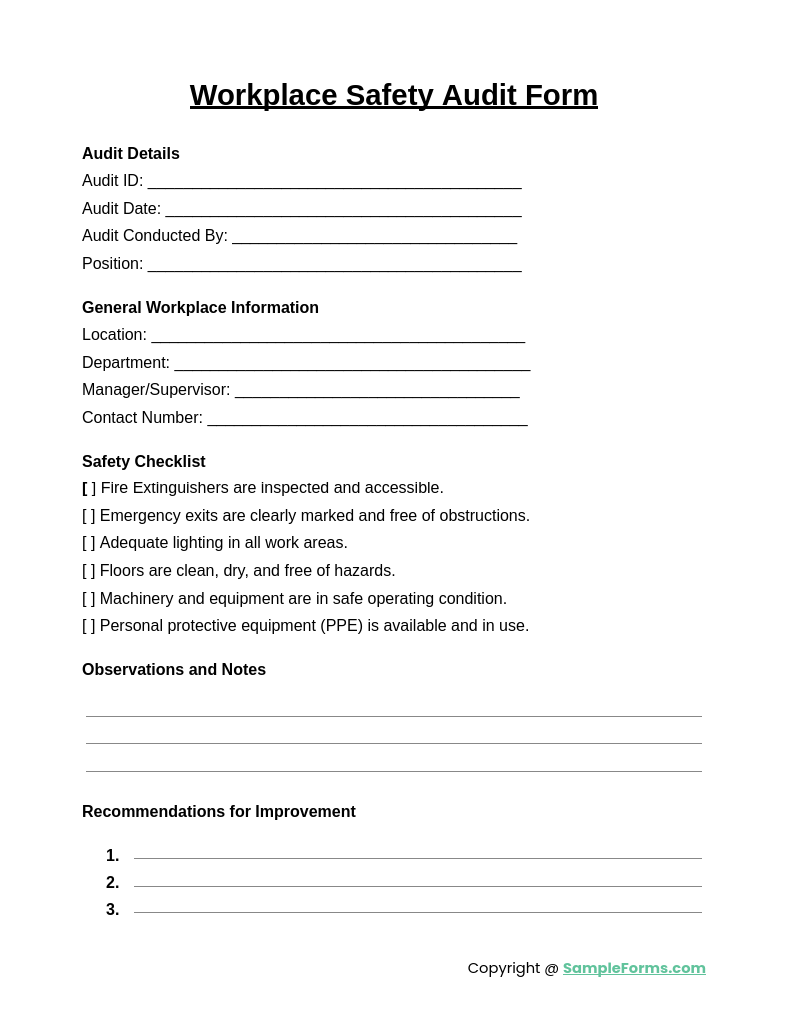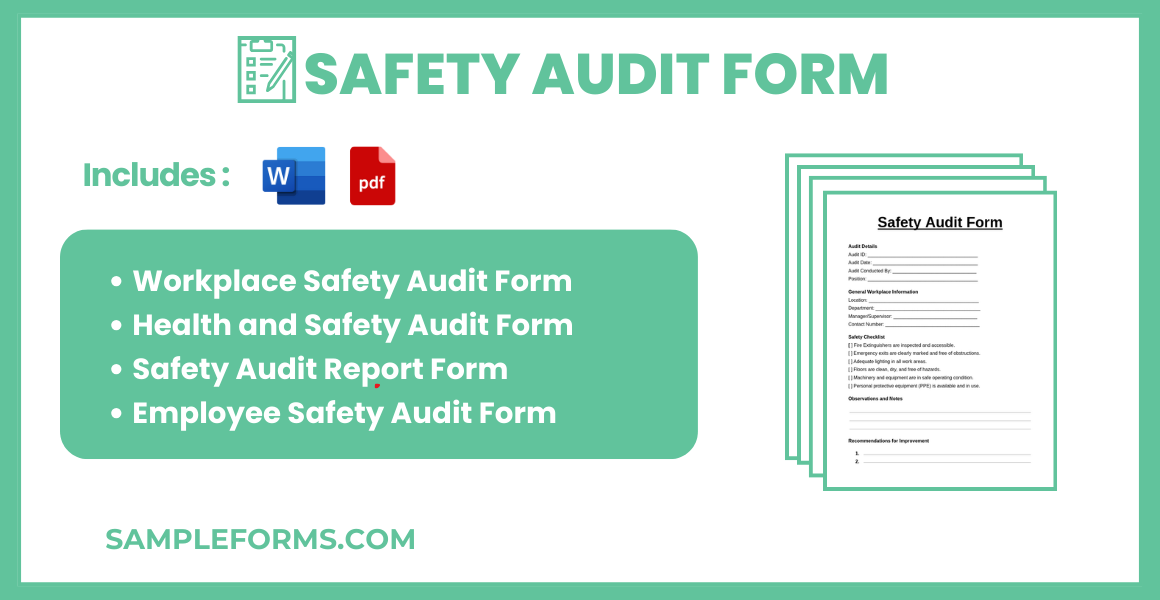A Safety Audit Form is essential for identifying risks, ensuring compliance, and maintaining a safe working environment. By documenting potential hazards and corrective actions, this form serves as a crucial tool for workplace safety management. Similar to a Internal Audit Form and Safety Report Form, it helps organizations streamline their safety audits and track performance. This guide provides step-by-step examples to craft efficient forms that align with regulatory requirements and foster a culture of safety.
Download Safety Audit Form Bundle
What is Safety Audit Form?
A Safety Audit Form is a structured document used to assess workplace safety practices, identify hazards, and ensure compliance with regulations. It records findings and suggests corrective actions for creating a safer environment, much like an Audit Form improves organizational efficiency.
Safety Audit Format
Audit Details
Audit Number: ____________________________
Audit Date: ______________________________
Auditor Information
Name: _________________________________
Position: _______________________________
Inspection Details
Area Audited: _____________________________
Key Observations: __________________________
Recommendations
-
- _____________________________
- _____________________________
- _____________________________
Acknowledgment
Auditor Signature: __________________________ Date: ___________
Workplace Safety Audit Form

A Workplace Safety Audit Form evaluates compliance with safety regulations, identifying potential hazards and corrective actions. It ensures safer environments, akin to the structure of a Safety Meeting Form for fostering workplace awareness and collaboration.
Health and Safety Audit Form

The Health and Safety Audit Form focuses on employee well-being and regulatory adherence. It ensures proper documentation of health practices, mirroring the systematic approach found in a Construction Safety Form for industry-specific requirements.
Safety Audit Report Form

A Safety Audit Report Form records detailed findings from safety evaluations, tracking risks and solutions. Its format is as organized as a Job Safety Observation Form, promoting efficient communication and actionable insights.
Employee Safety Audit Form

The Employee Safety Audit Form addresses workplace-specific safety concerns, ensuring individual compliance and protection. It reflects the clarity of a Job Safety Analysis Form, offering tailored solutions for enhancing employee safety standards.
Browse More Safety Audit Forms
1. Generic Safety Audit Report Form
2. Monthly Safety Audit Form
3. Health and Safety Audit Form
4. Safety Program Audit Instrument Form
5. Laboratory Safety Audit Form
6. Farm and Ranch Safety Audit Form
7. School Safety Audit Checklist Form
8. Arborist Safety Audit Report Form
9. Road Safety Audit Form
10. Office Safety Inspection Checklist & Audit Form
11. Building Safety Inspection & Audit Checklist Form
What should a safety audit include?
A safety audit should include hazard identification, compliance checks, and corrective action plans. It’s as comprehensive as a Safety Meeting Sign In Sheet.
- Hazard Assessment: Identify workplace hazards and evaluate their risks.
- Compliance Check: Ensure adherence to safety regulations and policies.
- Documentation Review: Verify records like training logs and equipment maintenance reports.
- Employee Interviews: Collect feedback on safety practices and identify potential issues.
- Action Plan Development: Create strategies to mitigate risks and enhance safety measures.
How to make a safety audit report?
A safety audit report outlines findings and recommendations for improving safety practices. Its structure is akin to a Safety Report Form.
- Executive Summary: Provide an overview of the audit’s purpose and findings.
- Methodology: Detail the methods used for inspections and evaluations.
- Findings: Summarize safety issues and risks identified during the audit.
- Recommendations: Suggest actionable measures to address hazards.
- Conclusion: Highlight key takeaways and the importance of implementing changes.
What is the purpose of an audit form?
An audit form ensures systematic safety evaluations, tracking compliance and risks. It serves a purpose similar to a Safety Acknowledgment Form.
- Standardized Evaluation: Provides a consistent framework for safety assessments.
- Risk Identification: Helps pinpoint hazards and areas for improvement.
- Documentation: Maintains detailed records for legal and compliance purposes.
- Performance Tracking: Monitors safety performance over time.
- Compliance Assurance: Ensures adherence to industry and legal safety standards.
How to prepare for a safety audit?

Preparation involves organizing documents, training employees, and addressing potential hazards. This process parallels using a Health and Safety Risk Assessment Form.
- Document Review: Organize safety records, policies, and procedures.
- Workplace Inspection: Conduct a preliminary hazard identification.
- Employee Training: Ensure workers understand safety protocols and expectations.
- Equipment Check: Inspect tools and machinery for compliance.
- Audit Checklist: Create a comprehensive list of areas to evaluate.
How to create a safety audit checklist?
A safety audit checklist ensures thorough evaluations by covering all critical areas, much like a Safety Risk Assessment Form.
- Identify Key Areas: Focus on equipment, processes, and employee behavior.
- Set Compliance Standards: Include relevant laws and organizational policies.
- List Inspection Items: Specify details like PPE usage and emergency preparedness.
- Review Documentation: Add items for checking records and reports.
- Prioritize Hazards: Highlight high-risk areas for immediate action.
Is safety audit mandatory?
Safety audits are mandatory for compliance with workplace regulations and ensuring employee safety, similar to using a Chart Audit Form for assessments.
Who is responsible for carrying out safety audits?
Safety officers or designated professionals perform safety audits, ensuring compliance and risk mitigation, akin to conducting a Financial Audit Form in finance.
How often should a safety audit be done?
Safety audits should be conducted annually or as per industry standards, similar to periodic reviews in a Desk Audit Form.
Who conducts safety audits?
Certified safety inspectors, internal teams, or external consultants perform safety audits, aligning with practices in a Quality Audit Report Form.
How long does a safety audit take?
Safety audits typically last a few hours to days, depending on scope, much like preparing a comprehensive Financial Statement Form.
Who is responsible for conducting audits?
Management appoints safety officers or hires third-party auditors for thorough evaluations, similar to assigning tasks in a Financial Assistance Form.
What areas do safety audits cover?
Safety audits cover hazards, equipment, processes, and compliance, akin to the comprehensive review scope of a Financial Contract Form.
What is the function of safety audit?
Safety audits identify risks and ensure regulatory compliance, reflecting the goal of creating clarity, like in a Financial Agreement Form.
What happens if you don’t comply with an audit?
Non-compliance leads to penalties, legal risks, or operational hazards, comparable to issues arising from inaccuracies in a Financial Disclosure Form.
What happens if you don’t comply with an audit?
Non-compliance results in penalties, operational risks, and safety concerns, similar to setbacks caused by neglecting a Finance Proposal Form.
A Safety Audit Form is vital for maintaining workplace safety and regulatory compliance. It identifies risks, ensures corrective actions, and supports ongoing safety improvements. Similar to a Financial Aid Form, it simplifies complex processes, providing a framework for achieving long-term safety goals. Explore our guide for examples and templates to enhance your safety audit practices.
Related Posts
FREE 40+ Incident Report Form Examples PDF
FREE 14+ Medical Report Forms PDF
9+ Sample Construction Management Forms Sample Forms
FREE 4+ Hazard Observation Forms PDF
FREE 7+ Confidential Report Forms in PDF DOC
Visit Report Form Samples
FREE 14+ Injury Report Forms in Word PDF
FREE 6+ Preventive Action Form in Sample, Example, Format
FREE 14+ Daily Report Forms PDF
Risk Assessment Forms
Sample Student Report Forms
5+ Breakage Report Forms in PDF DOC
5+ Benefits of Using Incident Report Forms
Sample Internship Report Forms
FREE 8+Sample Corrective Action Forms in Sample, Example, Format













